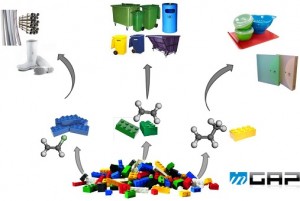US shale natural gas drives ‘significant uptick’ in chemical exports
Higher chemical trade activity will benefit key ports, terminals and logistics providers on Texas, Louisiana Gulf Coast
Despite low crude oil prices, new US shale gas-derived chemical expansions continue to move forward, and more than 100 million metric tons (MMT) of new capacity will be added in the U.S. chemical industry by 2025, according to a new report from consultancy IHS.
Much of that new capacity will be converted to plastics, significantly increasing the US net export position for these materials.
Major U.S. chemical production additions include ethylene, propylene, methanol, ammonia and their derivatives, such as plastics and fertilizer.
New domestic fertilizer production will replace imports from South America, the Black Sea and the Middle East.
The US shale gas impact on liquid bulk chemicals is less pronounced than for solids but still significant, according to the research, entitled IHS Chemical U.S. Bulk Chemical Export Expansion Analysis.
Recent production additions have resulted in a 10 million metric ton (MMT) increase in bulk liquid chemicals in the last year, and by 2025, US bulk liquid chemical additions will expand by more than 25 MMT, IHS Chemical said. The most notable bulk liquid chemical additions will be in methanol.
“Chemical producers are clearly looking to take advantage of continued low natural gas prices in the U.S., which is enabling the significant expansion of these methane-based projects,” said Chris Geisler, director, chemical consulting at IHS Chemical and author of the analysis.
 Reducing tubing wear, extend well run-times with EndurAlloy™ – J55 production tubing with boron diffused into substrate to create extra hard interior surface.
Reducing tubing wear, extend well run-times with EndurAlloy™ – J55 production tubing with boron diffused into substrate to create extra hard interior surface.
The vast majority of new olefin chemical production will be converted to solid plastic resins and exported, according to the IHS analysis. With the exceptions of the ammonia and fertilizer production chains, the vast majority of expansion will be centered in Texas and Louisiana. Within Texas, firm capacity additions stretch from Beaumont to Corpus Christi, including several within the Houston Ship Channel (HSC).
“With so many projects coming online, this phenomenal growth is changing the global trade landscape. Currently, the U.S. is a major importer of methanol, but by 2018, the U.S. will be a major net exporter of methanol, which is a significant shift for the U.S. industry,” said Geisler.
Geisler says solid fertilizer and plastics trade will change substantially in the US, as well as bulk liquids trade for products such as caustic soda, methanol and ethylene glycol.”
“This capacity expansion means there will be significant uptick in chemical trade activity and logistics considerations for not only producers and traders, but also the key ports, terminals and logistics providers, primarily on the Texas and Louisiana Gulf Coast,” he said
“As these chemical products expand, we expect to see increased marine, rail and truck traffic, primarily in the US Gulf Coast, but possibly later, that activity will expand to several of the East and West Coast ports and terminals.”
Base aromatics (benzene, toluene, xylenes) have not benefitted from the shale gas developments, but aromatic derivatives, particularly styrene, have benefitted, says Peter Feng, director of aromatics at IHS Chemical.
“Tight oil and shale gas have impacted the outlook for naphtha and octane, and unlike some of the other petrochemicals, there are only a limited number of expansion plans for North American aromatics,” Feng said.
Low U.S. gas prices are driving lower electricity prices, the IHS report said, which will likely incentivize US operators in the chlor-alkali chain to increase operating rates in the near-term and to expand long-term. This will result in more caustic soda production as a chlorine co-product.
The impact on trade flows, Feng said, has been quite pronounced: “North America will be a growing net importer of benzene and the region has flipped from being a net exporter of toluene, mixed xylene and paraxylene, to a net importer. From a logistics perspective, this will be important as ships transporting shale-gas advantaged production like methanol out of the region, will need products to bring back into North America as well.”
MTBE (methyl tertiary-butyl ether), although no longer used in the U.S. gasoline pool, is expected to see expanded export potential, IHS said.
Finally, ethylene glycol production will increase in the longer–term, moving the US from a net-importer to a net-exporter of this product. As other methanol, ethylene and propylene liquid derivatives are built, trade in bulk liquid chemicals will increase further, IHS said.
Through the study period of 2025, IHS Chemical expects capacity expansion in alpha olefins, ethoxylates, glycol ethers, MTBE, acetic acid and acrylic acid among others.
IHS Chemical says it is expanding on its report on bulk liquid chemicals to include plastics and fertilizers. The new expanded study, the IHS Chemical U.S. Chemical Industry Trade and Logistics in the Shale Gas Era Report,” will be available in second quarter 2016.








